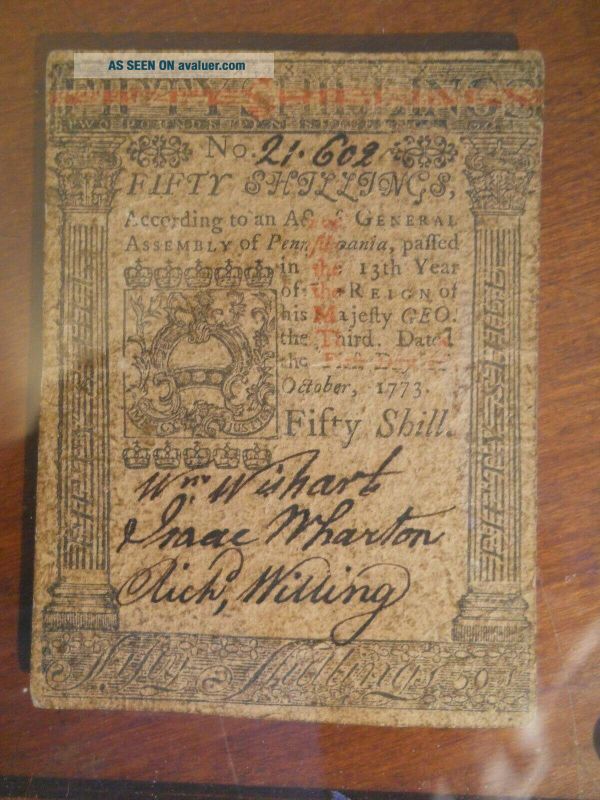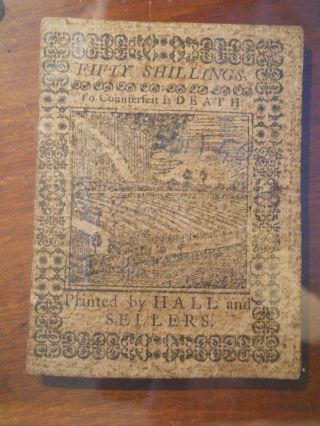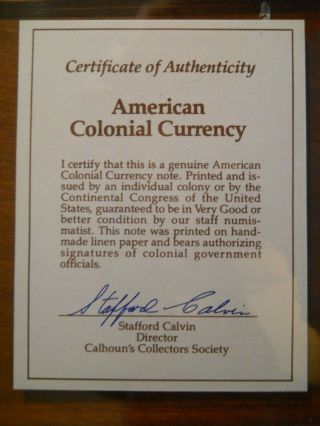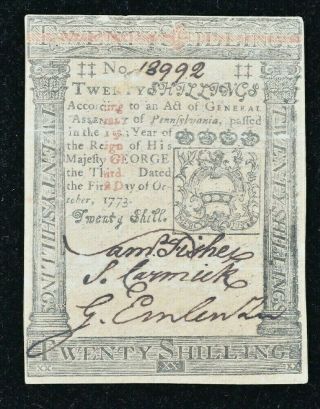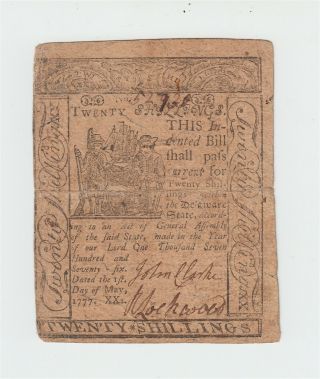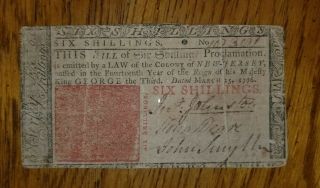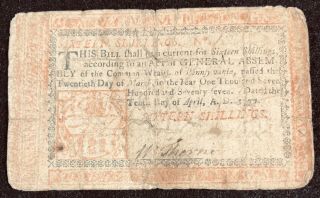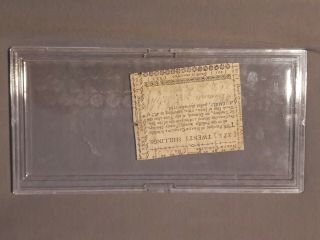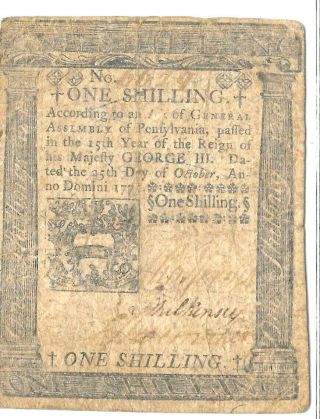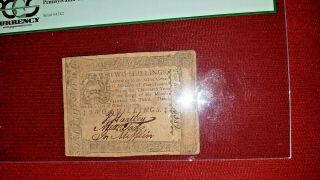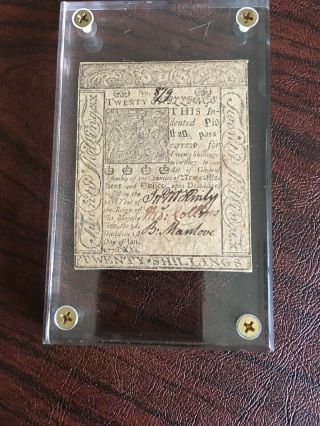1773 COLONIAL CURRENCY 50 SHILLINGS NOTE
Item History & Price
| Reference Number: Avaluer:35789087 |
1773 COLONIAL CURRENCY 50 SHILLINGS NOTE,
Pennsylvania No. 21602, Authentic official currency note with Certificates and plastic protection.
Calhoun's Collectors Society Certificate of Authenticity.
The importance of your acquisition is the fact the American colonial paper money was the FIRST such currency issued by any government in the western world, having great collector significance.
Shortly after landing in the New World, colonists became increasingly dissatisfied w...ith the barter system of trade between them and England. The colonists wanted and needed economic independence from Britain and sought to establish their own economic stability by printing paper money. Though in 1690 the Massachusetts Colony was the first to print paper money, each Colony eventually printed its own colonial notes to enhance a convenient exchange and pay off debt. While Spanish Dollars were popular as colonial coins (the origin of our “dollar” denotation for US money) currency was noted in British pounds, shillings and pence. Importantly, Britain disallowed Colonial Currency as legal tender in 1764, which contributed to great discontent with Britain among colonists. In addition to individual colony issued Colonial Notes, as the Revolutionary War began in 1775, the Continental Congress circulated paper currency to help finance the war, backed by a hoped for future tax income rather than real gold or silver. These Continental notes depreciated rapidly partly due to expert British counterfeit operations designed to sabotage US war efforts. Following the war, states and private banks continued to issue their own currency. However, because of the problems with depreciation, inflation, value variances, and counterfeit, the US Constitution later denied individual states the right to make their own money.
Colonial Currency Notes are rare and extremely valuable. They were a significant part of our heritage as an independent and free nation. To hold one of these is to hold a vital part of our social, economic and political independence from Britain.
Isaac Wharton, William Wishart, Richard Willing.
Good color in the red security printing, clear signatures, see scans.
A VOTE OF CONFIDENCE: ISAAC WHARTON AND THE BANK OF NORTH AMERICA
On February 9, 1782, Isaac Wharton, partner with his brother Thomas in a noted Philadelphia mercantile house, wrote a letter to Nathaniel Shaw, Jr., of New London, Connecticut. The subject of this letter, though not specifically mentioned, was the newly established Bank of North America.' By means of this correspondence Wharton hoped to inspire confidence in this novel financial venture. His concern for the return of stable economic conditions had been gained through painful experience during most trying times. Then, as now, government had contributed to an inflated currency, and the American Revolution had disrupted commercial relations between and throughout all the states.
Wharton had been born on September 15, 1745, into a family which had combined the wealth and social position of two dynasties which influence Philadelphia affairs to this day. His father, Joseph Wharton (1707-1776), a staunch Quaker, had risen by his own rewarding and diversified efforts from "cooper" to gentleman of leisure. The elder Wharton's prosperity as well as his mannerisms and personality had earned him the informal title of "Duke" or even the "Grand Duke" by his contemporaries. A close associate of Benjamin Franklin, in 1730 he married Hannah Carpenter, the granddaughter of Samuel Carpenter, a friend of William Penn who had emigrated to Philadelphia from Barbados. Carpenter rapidly became the wealthiest of the first generation Quaker settlers, second in means only to the proprietor himself.'
On 15 Aug. Richard Willing and John Wharton volunteered to escort the prisoners to Cambridge “on Condition of their Expenses being paid, ” and the next day the committee gave the two captains a letter of instructions regarding their mission (ibid., 305–6). Richard Willing (1745–1798), whom GW visited in Philadelphia on 21 May 1775 (Diaries, 3:331), was a captain in one of the battalions of Philadelphia associators. His companion may have been John Wharton (c.1732–1799), a Philadelphia shipbuilder who served on the Continental Navy Board from 1778 to 1780.
Pennsylvania No. 21602, Authentic official currency note with Certificates and plastic protection.
Calhoun's Collectors Society Certificate of Authenticity.
The importance of your acquisition is the fact the American colonial paper money was the FIRST such currency issued by any government in the western world, having great collector significance.
Shortly after landing in the New World, colonists became increasingly dissatisfied w...ith the barter system of trade between them and England. The colonists wanted and needed economic independence from Britain and sought to establish their own economic stability by printing paper money. Though in 1690 the Massachusetts Colony was the first to print paper money, each Colony eventually printed its own colonial notes to enhance a convenient exchange and pay off debt. While Spanish Dollars were popular as colonial coins (the origin of our “dollar” denotation for US money) currency was noted in British pounds, shillings and pence. Importantly, Britain disallowed Colonial Currency as legal tender in 1764, which contributed to great discontent with Britain among colonists. In addition to individual colony issued Colonial Notes, as the Revolutionary War began in 1775, the Continental Congress circulated paper currency to help finance the war, backed by a hoped for future tax income rather than real gold or silver. These Continental notes depreciated rapidly partly due to expert British counterfeit operations designed to sabotage US war efforts. Following the war, states and private banks continued to issue their own currency. However, because of the problems with depreciation, inflation, value variances, and counterfeit, the US Constitution later denied individual states the right to make their own money.
Colonial Currency Notes are rare and extremely valuable. They were a significant part of our heritage as an independent and free nation. To hold one of these is to hold a vital part of our social, economic and political independence from Britain.
Isaac Wharton, William Wishart, Richard Willing.
Good color in the red security printing, clear signatures, see scans.
A VOTE OF CONFIDENCE: ISAAC WHARTON AND THE BANK OF NORTH AMERICA
On February 9, 1782, Isaac Wharton, partner with his brother Thomas in a noted Philadelphia mercantile house, wrote a letter to Nathaniel Shaw, Jr., of New London, Connecticut. The subject of this letter, though not specifically mentioned, was the newly established Bank of North America.' By means of this correspondence Wharton hoped to inspire confidence in this novel financial venture. His concern for the return of stable economic conditions had been gained through painful experience during most trying times. Then, as now, government had contributed to an inflated currency, and the American Revolution had disrupted commercial relations between and throughout all the states.
Wharton had been born on September 15, 1745, into a family which had combined the wealth and social position of two dynasties which influence Philadelphia affairs to this day. His father, Joseph Wharton (1707-1776), a staunch Quaker, had risen by his own rewarding and diversified efforts from "cooper" to gentleman of leisure. The elder Wharton's prosperity as well as his mannerisms and personality had earned him the informal title of "Duke" or even the "Grand Duke" by his contemporaries. A close associate of Benjamin Franklin, in 1730 he married Hannah Carpenter, the granddaughter of Samuel Carpenter, a friend of William Penn who had emigrated to Philadelphia from Barbados. Carpenter rapidly became the wealthiest of the first generation Quaker settlers, second in means only to the proprietor himself.'
On 15 Aug. Richard Willing and John Wharton volunteered to escort the prisoners to Cambridge “on Condition of their Expenses being paid, ” and the next day the committee gave the two captains a letter of instructions regarding their mission (ibid., 305–6). Richard Willing (1745–1798), whom GW visited in Philadelphia on 21 May 1775 (Diaries, 3:331), was a captain in one of the battalions of Philadelphia associators. His companion may have been John Wharton (c.1732–1799), a Philadelphia shipbuilder who served on the Continental Navy Board from 1778 to 1780.



